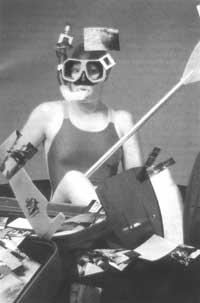To extend the life of photos...
The phenomenon called photography involves the intentional degradation of light-sensitive materials by using light and chemicals. However, photographs should be protected from these agents to prevent them from deteriorating as a result of this degradation. In addition, once degraded, this sensitive material is imperfect and with sufficient contaminating content. This is the core of the conservation problem that generates the management of photographs, films or papers. Photography is chemically unstable and some elements such as light, heat, moisture or chemical agents shorten your life.

USA began to address these issues long ago. and in Great Britain, but there it also does not know wide audiences the techniques of protection and conservation of the photos. The good articles that appear in the commercial catalogues of presentation, classification and archive of photons meet the scientific standards. But it is also true that good quality products are expensive. However, if you want to keep professional or family images, they offer security.
The type of film has an important role
Ordering photos is a real art that requires a few knowledge. You have to know, for example, that black and white is more stable than color, since the colors degrade also in the dark. As light is a harmful factor, its stability in the dark (where it has been archived) will have much to do with the life of photography. Research centers for the conservation of graphic documentation, for example, recommend the use of aging-resistant products resulting from graphic processes, such as ciacrome in paper strips or codakromo in slides.
Temperature is also a factor to consider. Not much heat suits them. The optimal storage temperature is from 18ºC to 21ºC. But the problem is to unite low temperature and low humidity. The most suitable relative humidity, especially in color photographs, is usually around 35% and it seems difficult (if not impossible) to get it in a room. Therefore, it must be conformed with a relative humidity between 40 and 60%. A relative humidity greater than 60% degrades the dyes. The black and white ones yellow (especially if after the development are cleaned badly and remains of fixing salts, which sulfurizes the silver layer). Cameras and basements are totally inadequate spaces for use as filing cabinets, due to the great variability of temperature and humidity.
The environment therefore negatively influences the conservation of photographs. In addition to the increasing pollution and emission of vapors as a destructive agent, some file systems (boxes, plastic sheets with pocket, furniture, etc.) can be harmful. ). ).
Some gas-releasing compounds produce chemical reactions that damage colored layers. They are plastic items, solvents, cardboard, resin wood and rubbers that carry many commercial products. You also need to be careful with acrylic lacquers or varnishes (as they contain solvents and catalysts) with new painted furniture and boxes or with oxidable metal boxes and furniture. Therefore, another condition for stability, neutrality and conservation is the purity of materials.
Be careful with the photo-pockets and acidic PVC papers. Many studies refer to the risks of currently plasticizing and chemically unstable paper and cardboard. PVC (polyvinyl chloride), widely used for storing photographs, is not recommended at all. This substance, which undergoes changes with the migration of plastification, releases phthalates that attack the silver layers. On the other hand, it tends to yellow and be fragile. And it is perfectly possible to release acidic vapors in this process.
This product is classified as pollutant by European environmental currents. He is accused of not being able to destroy. As a result, manufacturers are investigating neutral, unplasticized products. Experts in graphic documentation conservation recommend replacing PVC with three materials: polyester, polyethylene and polypropylene. And among these three give priority to polyester, because it is more durable and more stable. On the other hand, it should be mentioned that there are different qualities of polyester that are marketed as different trademarks.
But the most important thing is to choose pure polyesters. This is because, depending on their destination (for example for food collection), it is mixed with substances harmful to photons such as PVC.
Chemically stable, acid-free, fully transparent and resistant polyester is neutral to silver coatings. But it has two small drawbacks: on the one hand it is electrostatic, so it attracts dust and, on the other, it is waterproof and there is the risk of accumulation of water vapor, which, as has been said, is harmful to photographs. Pockets that are not too tight should also be checked and avoid sticking so that air circulates properly.
On the other hand, to preserve the photographs, the best papers are neutral, that is, with a zero acidity rate. They are cotton papers and glued with neutral glue (to make pockets or glue photons). The books of the time when paper was invented bear witness to the physical and chemical quality of these compounds. Acidity of paper XIX. It is a question of the mid-twentieth century (after the use of the gluing pulp and the colophone) with harmful effects: it produces a progressive degradation of cellulosic fibers and alter the documents that are preserved in these papers in the presence of moisture, especially by the migration of acidic substances. As for glass paper, although it has not been proven that it can altar the photons to aging, its cellulosic fibers, very worked and fragile, are acidified and yellow over time.
To avoid the archival problems of these papers, manufacturers have begun to produce “durable papers”. They started in the United States and Britain.

The characteristics of sustainable papers, pH, alkaline reserve and already manufactured pasta. The pH (hydrogen potential) determines acidity, neutrality or alkalinity. Scale from 0 to 14. From 0 to 6 the paper is acidic; from 8 to 14 it is alkaline and the neutral is a pH of about 7.
But for its conservation it is not enough that the paper is not acidic. Black and white films and papers should be “plugged”, that is, an alkaline charge, such as calcium carbonate, should be added to the mass to neutralize acids from the atmosphere. As for paper paste, it must have a minimum content of alfacellulose and no lignin, as it is a substance that weakens the fibers and produces acid.
The criteria currently used for the selection of paper are pure bleached cellulose, rich in alfacelluloses (minimum 89%); fibers not attached to lighting; those of pH between 7.5 and 9; the alkaline reserve of calcium carbonate (minimum 3%); the absence of optics. In the case of color photographs (films and tests) it is preferable to use papers without alkaline reservations (from pH 7 to 7.5).
These are, in short, the criteria recommended by experts in the archive.
In the USA standards and specifications have been established to define the role characteristics that manufacturers must meet (ANSI, American National Standard Institute, standards and NBS, National Bureau of Standards, standards).
ISO (International Standardisation Organisation) standards are derived on how to archive photons (films, plates and papers). But these standards have been established taking into account only large archives (museums, libraries and public and private collections), which have not been adapted to a smaller level. This vacuum allows manufacturers to market their products without predicting what will happen over time.





